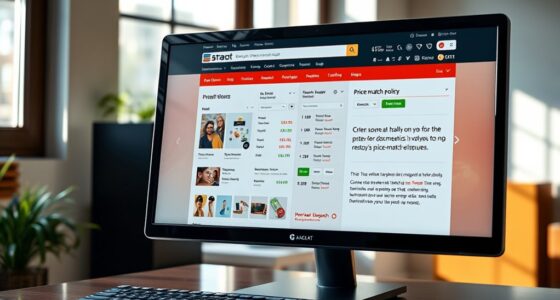Did you know that nearly 70% of online shoppers rely on price history and deal patterns before making a purchase? As a savvy consumer, understanding how to interpret Amazon’s deal page can save you money and prevent impulsive buys. By analyzing key data points, you can distinguish between genuine discounts and temporary fluctuations. Curious about the tools and techniques that can give you an edge in spotting the best deals? Keep reading to learn how to approach Amazon like a data analyst.
Key Takeaways
- Analyze price history and trends using tools like CamelCamelCamel or Keepa to identify genuine discounts.
- Compare current deal prices with similar products and historical data to assess deal attractiveness.
- Evaluate customer reviews for authenticity and insights on product value and potential hidden issues.
- Check for consistency and stability in price fluctuations to avoid short-term markdowns or inflated prices.
- Confirm deal legitimacy by cross-referencing reviews, ratings, and considering security and authenticity cues.

If you want to make the most of Amazon’s deal page, you need to approach it like a data analyst. Instead of just glancing at discounted prices, start by examining the price trends. Look for patterns in how the price has shifted over time, which can tell you if a deal is genuinely good or just a temporary markdown. Use tools like CamelCamelCamel or Keepa to track the price history of a product. These tools show you whether the current price is at a historic low or if it’s been fluctuating wildly. Recognizing these trends helps you avoid overpaying during short-term sales that may not be as attractive once the price stabilizes. Comparing price trends across similar products also offers perspective. If multiple alternatives have stable or lower prices, it might be worth considering those instead of plunging into a deal that looks good only because of a temporary dip. Additionally, understanding the security vulnerabilities in new payment technologies can help you evaluate the safety of online transactions. Customer reviews are equally critical in evaluating a deal. Plunge into what buyers are saying about the product, especially recent reviews, to gauge its quality and authenticity. Pay attention to reviews that mention price satisfaction or if buyers felt they got a good deal. Sometimes, a product with a steep discount might have hidden issues, and customer reviews reveal those insights. Look for patterns in reviews—are many people complaining about durability, functionality, or customer service? If reviews consistently highlight problems, even a heavily discounted item might not be worth your money. Conversely, a product with positive reviews and high ratings, despite a modest discount, might be a smarter buy. Reviews also help you verify if the deal is legitimate or if it’s a marketing tactic to create false urgency.
Conclusion
By applying data analysis techniques to Amazon’s deal page, you turn a simple shopping trip into a detective quest. Tracking price trends, comparing deals, and reading reviews helps you see through the smoke and mirrors to spot genuine savings. Like a seasoned navigator, you’ll steer clear of false discounts and find the real treasure. Mastering these skills transforms your shopping from guesswork into a calculated move—making every deal a jewel in your crown.









